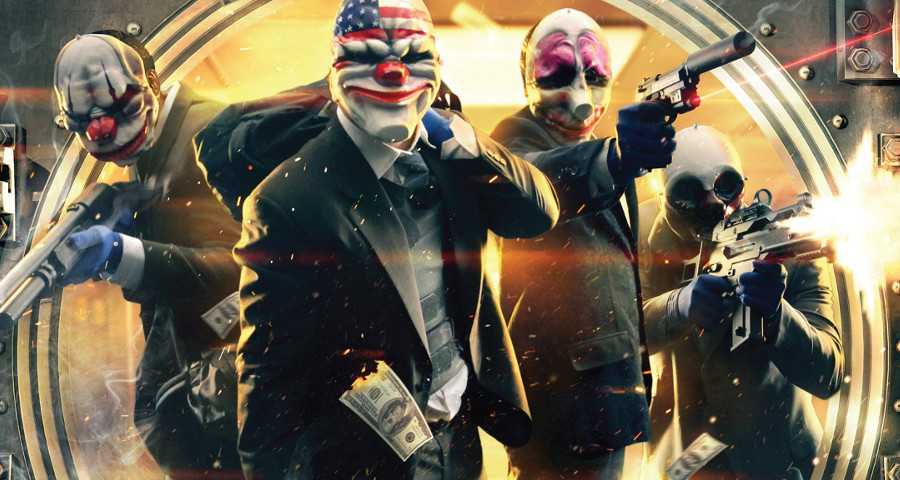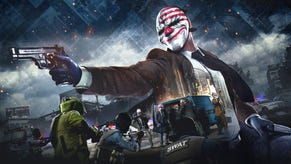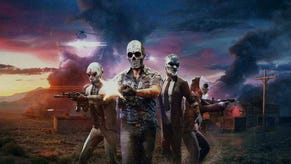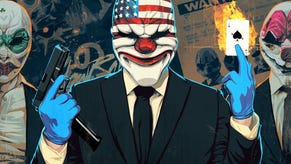The making of Payday 2: from '1.5' project to heavyweight sequel - part one
Payday 2 was a resounding success for Overkill Software, turning a profit before it even launched. VG247's Dave Cook speaks with director David Goldfarb about how it went from incremental update to full-blown sequel.
As gamers who are regularly spoon-fed hype from the big marketing predators that dominate our industry, it's understandable that some people simply cannot look past the blockbuster pack and down to the mid-tier. That this proving ground of innovation, talent and new IP is so savagely overlooked or branded as irrelevant by John Q. Public is frustrating to witness. It's a changing tide however, triggered in part by the growing apathy surrounding sequels and rising prominence of indies and the mid-tier pack.
”For - I want to say it was the first three or four weeks - it was like, 'yeah this could be done,' but there were definitely people that were like, 'why are we changing it? What we did worked on Payday 1, this is a big risk.' That was definitely not the easiest time."
Payday 2 is arguably one of 2013's most inspiring success stories, turning a profit before release thanks to Steam's pre-purchase model, and generating enough interest and funds to prove that you needn't have the backing of Activision or EA to make your bread. Developed by Overkill Software and presided over by Starbreeze Studios, Payday 2 is about coordination, teamwork and trust. These same values helped the project rise from a simple, iterative add-on to the original and flourish into something bigger.
Helming the game's ongoing development is former DICE and Guerrilla Games man David Goldfarb. I was fascinated to learn more about the project's origins and how its success has been met by a studio that now finds itself rolling with the heavyweights. Comfortingly enough, he and his team are humble and don't see Payday 2's strong performance as an invitation to sell out to the top tier or cash-in. If anything, it's validation that strong ideas and solid execution win the day, not just which studio has the bigger advert or ability to spew the most hyperbolic nonsense.
"I took some time off between leaving DICE and then coming over and starting at Starbreeze," Goldfarb told me over Skype. "When I got there they had kind of a rough design, they had some stuff under-way. The bag picking-up mechanic was, if not already there, I think it was happening, so there were definitely some things in the pipeline.
"It was very, very early, and I think a lot of the initial plans were kind of like, 'do Payday 1.5,' which was very sensible from a production perspective. It just so happened that wasn't what we wound up doing. None of the stealth or RPG stuff existed in any form, or any of the systemic stuff. That was all new. So the game was pretty much made in the last year."
Initially, Overkill had hoped to play things safe and create something that felt additive to Payday: The Heist without reinventing the format. As Goldfarb suggested, it was a smart strategy for a studio that had found a great deal of success at first, but hadn't perhaps found the confidence to go above and beyond. It's hard to imagine a simple add-on with new maps and none of the role-playing progression or stealth options of Payday 2 performing quite so well at market. That would have been quite a different game.
Unfortunately, Goldfarb entered the fold to find that indeed, Overkill's talent was in doubt. Could it perhaps expand the format in ways it had not yet conceived? Undoubtedly, but given the team's size - currently about 35-40 people - it seemed like a big challenge. What followed was a process of looking at the possibilities and playing around with ideas on Payday 2's jewellery store test map, which later became inducted as the shooter's first mission.
”It always became more complicated when it was a stealth mission, because there's so much intersection of different mechanics, skills, armour and other things, along with the level design itself. It's an order of magnitude more complex than making the old maps for Payday which, were themselves, super-complex."
"When we started," Goldfarb recalled, "I remember [Overkill co-founder Ulf Andersson] and I were talking about in the beginning - without any of the skills or anything that we had, because that came later - could we make a convincing case for doing a short mission that kind of allowed you to get away without having to kill anyone, or at least in a way that felt you weren't just fighting endless waves of dudes. So we made this jewellery store thing which required a lot out of level design, a lot of QA time and people working.
"Together, I think we collectively burned a lot of brain cells on how we were going to make this gameplay dense and interesting enough so that it feels like playing it for five minutes will be rewarding and different every time. For - I want to say it was the first three or four weeks - it was like, 'yeah this could be done,' but there were definitely people that were like, 'why are we changing it? What we did worked on Payday 1, this is a big risk.' That was definitely not the easiest time."
While it took some convincing, Goldfarb and the team rolled with the concept and persisted through the challenges and doubt that followed. While this may be seen as problematic in some work environments, Overkill and Starbreeze encouraged questioning. If something felt broken, out-of-place or simply foolish, the team voiced their concerns and acted accordingly to the benefit of Payday 2's design. In the end that democratic approach led to a grander project with a vast array of gameplay mechanics and strategic avenues.
One glance at YouTube reveals a wealth of Payday 2 speed runs. The first moment it fully clicked for me was watching a video of four online players employ immense coordination to successfully break into the jewellery store, cable tie every NPC and guard in there, fill up loot bags and make off with the spoils without alerting a single cop. In 35 seconds. It was an incredible feat, and while we're clearly not all that good, you can appreciate the game's full scope once you start to level up your robber. Running and gunning is only one option available to you, and in many cases, the least satisfying.
Over time you start to realise different ways you can prod the game world and have it react accordingly. For example, your robber has the ability to pacify a guard and pose as him once his superiors call in for a status report. You don't sound all that convincing at first as you bluster your way through it. Chances are the guy on the other end of the line won't believe you and send in waves of reinforcements. Level up the necessary stats however, and you can quickly reply with an authoritative ruse to delay backup every time. Little perks like this go a long way as you progress, but the entire stealth mechanic simply wasn't there when Goldfarb joined the team.
"As I recall the early stealth mechanic was literally, 'get these bags out of the store,'" Goldfarb explained. "It kind of started with, 'okay, we know that you can take these things and the cops are going to come, but we need an alarm then don't we?' All of those things were just special case things in the level design that would say, 'okay now the cops need to come.' What ended up happening was that for special case stuff, we had to build them as a system and we would have to reverse-engineer some of the level design into it, so [players] had some control over stuff in that way.
”The thing I came away from with Battlefield was definitely the experience of what the player does, as opposed to what you tell the player they’re doing. A lot of it was going, ‘yeah, the whole player education thing. People are smart, they’re going to figure it out."
"The early days of stealth were more about extending the length of the heist, more than a proof of concept for stealth. Then we kind of looked at it and thought, 'yeah this could be pretty fun if you could tackle this in a bunch of different ways.' We knew we wanted to do stealth so, 'okay we need a bunch of stuff.' That's how it began, talking about, 'well we need this alarm,' and then guards to detect you, then two states. That conversation went on and on, like how are we going to have these multiple states and isn't that super-confusing for people, mask on and mask off. All that s**t went on for months."
Goldfarb's not wrong; Payday 2 can be an incredible confusing experience on your first few heists, but understanding comes through practicality. Simply do things to see their resulting effect and over time you'll start to understand the laws of the world. That such exploration is encouraged in what - on the surface - looks like a straight up co-op shooter is what renders the game so compelling. Once you use those tools and manipulate the mechanics to pull off a clean getaway, the sense of achievement is ludicrously gratifying. If you fail, chances are you want to retry straight away to do better.
One mission - dubbed 'Framing Frame' - is a masterclass in tiered design. The first stage of the heist sees your squad infiltrating an art gallery to steal paintings. Once acquired they are then sold to a senator and hung up in his fortified mansion. Little does he know that the crew has positioned hidden cameras in each painting so that they can spy on his home, map out guard paths and formulate a plan to steal evidence on USB sticks and laptops dotted around the compound. One player can man the camera feeds and call out updates, while the other three can pull off the robbery. It's fiendishly intricate, challenging and expertly-designed.
"The approach for those missions was the same [as the jewellery store heist] in so far as all the missions are approached knowing the limits we had on stuff," recalled Goldfarb. "But with the stealth missions it was always important for them to not feel too easy. If you can take down all the guards too easily then obviously there's not a lot left for you to do in a level. Although that's fun for some people it's hard to sustain, so I liked that there was more attention given that stuff in missions that weren't just an assault where you don't have to worry about stealth."
"It always became more complicated when it was a stealth mission," he added," because there's so much intersection of different mechanics, skills, armour and other things, along with the level design itself. It's an order of magnitude more complex than making the old maps for Payday which, were themselves, super-complex. That's one unfortunate reality that, it'd be awesome if we could do those big maps in the same amount of time, but in reality it takes a lot longer. Even though we know the thing we need the most are these big, complex heists it just takes an enormous amount of time."
There's no shortage of fun heists to pull off in Payday 2, so it's clear that Overkill and Starbreeze fired on every cylinder to cram as much into the package as possible. Even once you're done with them all, there's no shortage of replay value with friends or strangers online, coupled with that addictive sense of betterment that comes with knowing where you slipped up, broke stealth or missed a bag of loot. There's also narrative tying all of the thefts together, but Goldfarb conceded that it's secondary to the raw experience.
From Goldfarb's perspective, he felt that less narrative would be more, and that the levels and jobs themselves should star front and center. He added, regrettably, that perhaps Overkill didn't make the play-spaces feel populous enough with narrative cues - as opposed to cut-scenes or text dialogue. I asked him how that felt, coming from DICE and Guerrilla, two studios that each present games with an over-arching and tangible narrative, complex characters and dense worlds with themes. What did that experience bring to the table?
"I never have a good answer for this," Goldfarb replied humbly. "There are definitely things - I guess - that come from working on a big multiplayer game, and I guess stuff that just becomes part of you after a while, whether it's gun mechanics. The thing I came away from with Battlefield was definitely the experience of what the player does, as opposed to what you tell the player they're doing. A lot of it was going, 'yeah, the whole player education thing. People are smart, they're going to figure it out.
"Battlefield was not an easy game, but people are doing well they can fly jets or whatever. Payday 2 definitely has some complexity similarities. People are willing to trawl through the skills, figure out the mechanics and do all those things, so I think raising our hands and saying, 'It's okay to screw up,' and allowing people to just screw around with the systems you make and not coaching them. That definitely for me is something I remembered from battlefield, even if I distrusted it at the time.
"It's more and more something I came to understand as the project continued. It'd be hard for anyone to say what bring to the table without sounding kind of absurd [laughs], so I'm not going to say anything. I'm good at some stuff but not good at other stuff, and all anybody wants to do in the end is make something good, and get more knowledge about what you do better and what you do worse from game to game. I'll have to plead the fifth on that one."
Join us tomorrow for part two of our discussion with David Goldfarb, in which we discuss the day Payday 2 turned a pre-launch profit, how Overkill met the game's success, what its plans are for 2014's DLC and much, much more.













